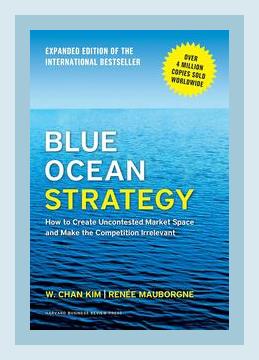Business StrategyBlue Ocean Strategy
Title: **
Introduction
“Blue Ocean Transformation: Rethinking Business Models” by David Warren, published in 2020, delves into the strategic importance of pioneering uncharted market spaces—termed “blue oceans”—where competition is irrelevant, and opportunities are vast. Rooted in the broader Blue Ocean Strategy framework popularized by W. Chan Kim and Renée Mauborgne, Warren’s book focuses on transforming traditional business models to innovate and pursue growth away from saturated markets.
1. Understanding the Blue Ocean Concept
Key Point: Blue Oceans vs. Red Oceans
Example: Warren uses the analogy of red oceans teeming with fierce competition, often leading to reduced profit margins and stagnant growth. In contrast, blue oceans are those untapped market spaces where new demand is created, and competition is non-existent.
Action: Conduct a competitor analysis to identify whether your business is in a red ocean. If so, start brainstorming potential blue ocean strategies by creatively combining existing products or services to meet unarticulated customer needs.
2. Definition of Value Innovation
Key Point: Value Innovation as the Cornerstone
Example: Cirque du Soleil’s reinvention of the traditional circus is highlighted. By combining elements of theater with circus performances, they created unprecedented buyer value, attracting a wide range of customers beyond the typical circus-goer.
Action: Examine your industry and pinpoint elements that can be eliminated, reduced, raised, or created. This exercise can help identify ways to reconstruct market elements for unprecedented value.
3. Identifying Opportunities through the Four Actions Framework
Key Point: The Four Actions Framework (Eliminate-Reduce-Raise-Create)
Example: Southwest Airlines eliminated services like meals and seat assignments but raised customer service and created a friendly, quirky brand image, simplifying processes and cutting costs radically compared to traditional airlines.
Action: Use the ERRC grid (Eliminate, Reduce, Raise, Create) to reassess your business processes. This will help in discovering how to cut costs and enhance customer value simultaneously.
4. Reconstructing Market Boundaries
Key Point: Pathways to Identify Blue Oceans
Example: Warren discusses Nintendo’s Wii, which reconstructed market boundaries by targeting non-gamers through intuitive motion-sensing technology, diverging from the high-definition graphics race among existing competitors.
Action: Identify alternative industries and strategic groups that could inspire a blue ocean strategy. Investigate how customer roles might shift or how market trends could evolve to create new demand.
5. Focusing on the Big Picture, Not the Numbers
Key Point: Seeing Beyond the Metrics
Example: In another case, Tata Motors focused on the broader picture of providing affordable transport rather than getting bogged down by the intricacies of auto manufacturing metrics, which led to the creation of the Tata Nano.
Action: Develop a strategy canvas to visually plot your current competitive factors and rethink how to shift focus towards the larger vision and unmet customer needs.
6. Reaching Beyond Existing Demand
Key Point: Tapping into Non-customers
Example: Netflix initially targeted movie enthusiasts looking for an alternative to video rental stores, eventually refining its model to tap into the wider market of digital streaming.
Action: Identify three tiers of non-customers: those who are on the edge of your market, those who consciously choose against your market, and those who have never considered your market. Develop strategies to convert these non-customers.
7. Building Execution into Strategy
Key Point: Aligning Strategy with Execution
Example: IKEA’s flat-pack furniture model streamlined manufacturing and logistics, aligning its strategy with cost leadership and ease of customer assembly without compromising design aesthetics.
Action: Use a strategy-to-execution (S2E) plan that outlines each step needed to implement your blue ocean strategy. Assign responsibilities and monitor progress through key performance indicators to ensure alignment.
8. Overcoming Organizational Hurdles
Key Point: Addressing Cognitive, Resource, Motivational, and Political Hurdles
Example: The case study of Nespresso reveals how they overcame internal resistance by demonstrating the potential profitability and customer appeal of their unique coffee pod system.
Action: Cultivate a culture of collaboration and transparent communication. Take specific steps to address and mitigate internal resistance by providing evidence of potential success and benefits from your blue ocean strategy.
9. Innovation Alignment and Fair Process
Key Point: Ensuring All stakeholders are Invested
Example: Warren discusses the case of El Bulli, a Spanish restaurant that was a pioneer of molecular gastronomy. They engaged their staff and customers in the creative process, making them co-creators.
Action: Apply the fair process principles (engagement, explanation, clarity of expectation) in your strategic planning to ensure employees and other stakeholders are fully invested in the innovation process.
10. Sustaining Blue Ocean Strategies
Key Point: Continuous Evolution and Adjustment
Example: Apple’s continuous transitions are cited, such as moving from iPods to iPhones to services like Apple Music, showing an ongoing commitment to finding new blue oceans while evolving their existing blue oceans.
Action: Create a strategic renewal cycle that emphasizes continuous scanning for new opportunities, regular reassessment of market dynamics, and iteration of your value proposition.
Conclusion
In “Blue Ocean Transformation,” David Warren equips businesses with the tools and strategic mindset necessary to break out from overcrowded and competitive markets into innovative arenas brimming with potential. Emphasizing the need for consistent reassessment and agile execution, the book offers a comprehensive guide for businesses ready to chart their courses into untapped markets.
By addressing each major point, Warren not only provides numerous examples from diverse industries but also actionable steps for businesses keen on transforming their existing models. The essence of a successful blue ocean strategy lies in value innovation, insightful market reconstruction, and embedding the strategy into every organizational layer to ensure sustainable competitive advantages. The book stands as a vital resource for leaders and strategists aiming to explore and dominate their own blue oceans.
